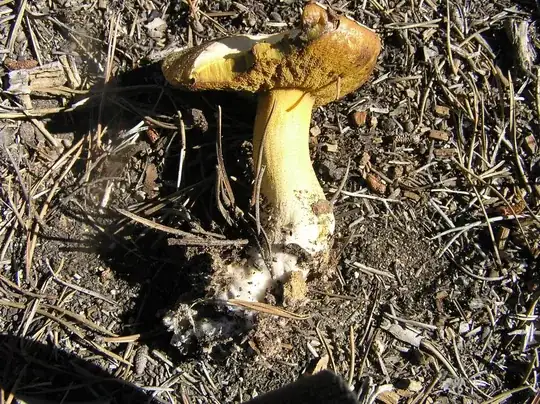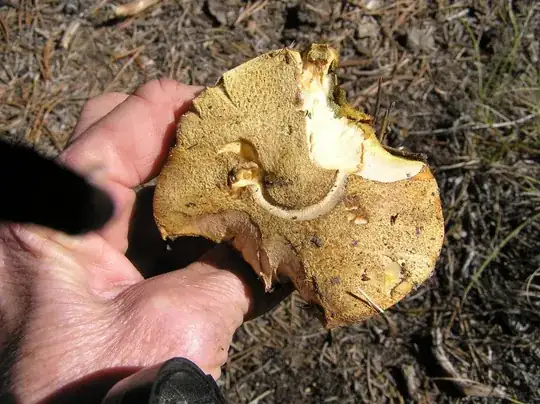This mushroom grows in Oregon's high desert in lodgepole pine forest. It is big, 4-6" high and wide. Bright orange with yellow meat. Definitely a parasol type.


This mushroom grows in Oregon's high desert in lodgepole pine forest. It is big, 4-6" high and wide. Bright orange with yellow meat. Definitely a parasol type.


DISCLAIMER
As all mushrooms are notoriously hard to identify via internet, this is not a free pass to eat everything that you might encounter. Always double check with a good reference book and - preferrable - a local knowledgeable, experienced and certified person. Some mushrooms have a range of colour that varies from one place to another (different soil, micro climate etc.), locals should know about what is typical. If in doubt, enjoy your find, take pictures and have an apple instead.
Based on 20+ seasons of mushroom picking, albeit in Germany, I'd identify this as a Suillus Variegatus (variegated bolete, velvet bolete). According to wikipedia, this species can also be found in Northern America, but the English wikipedia article is not very good, so no link from me here.
The color range is in the yellows with sometimes orange or olive hues or "dusting" on stem and cap, spore tubes are tight, even in older specimen and darkish olive, especially at the ends. May "bleach out" with age, especially in dry wheather. Cap appears "velvety" or "sandy" (German: "Sandröhrling", roughly: sand-tube-mushroom)
Flesh yellow-to-cream coloured, younger ones tend towards orangeish-yellow, older may be lighter, especially in dry conditions. Some blue discoloration when cut or bruised (instantly or within minutes), depending a lot on wheather: more on younger specimen in a rainy season or on humid ground, less to none in older ones after a dry spell. According to various reports, the degree of blueing might be regionally different.
Cap thick, first rounded, then stretched out, up to ca. 5in. Stem thick, solid, but not as "massive" as with boletus edulis or boletus erythropus, more like boletus badius, No net, or other surface structure.
Loves pines.
Edible and tasty, similar to other sullius or boletus, but not as firm as a king bolete. (Again: note disclaimer on top.)
The stem doesn't look like a Boletus. I think it might be an old Bay Bolete (Xerocomus Badius).